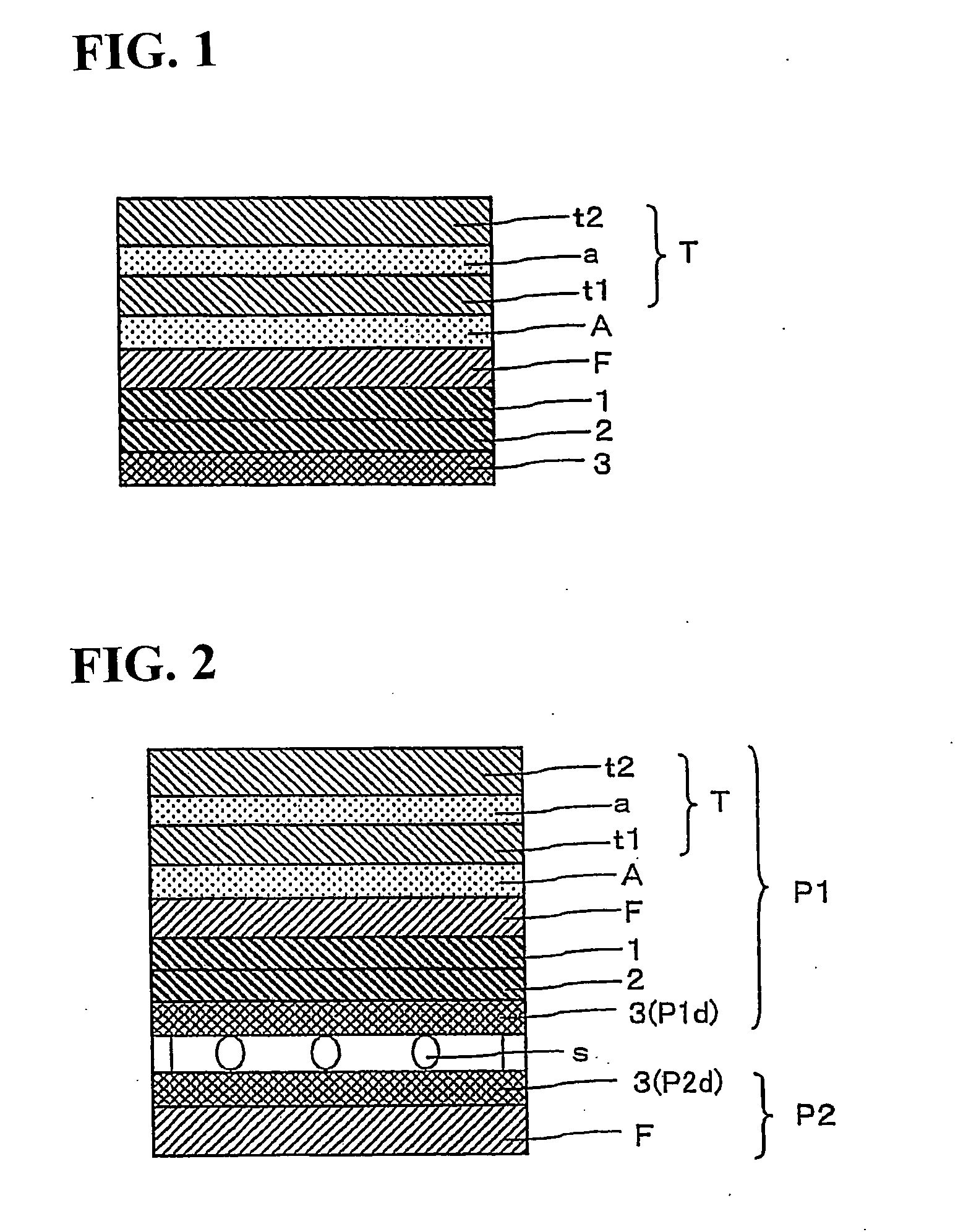Transparent conductive laminate and touch panel
a technology which is applied in the field of transparent conductive laminate and touch panel, can solve the problems of low flexibility or workability, inability to use certain purposes, and low transparency, and achieve good bending properties, good scratch resistance, and suppress the effect of transmitted light coloration
- Summary
- Abstract
- Description
- Claims
- Application Information
AI Technical Summary
Benefits of technology
Problems solved by technology
Method used
Image
Examples
example 1
Formation of First Transparent Dielectric Thin Film
[0060]A first transparent dielectric thin film (with a light refractive index n1 of 2.1) of a complex oxide containing 100 parts of indium oxide, 10 parts of tin oxide and 25 parts of cerium oxide was formed by a reactive sputtering method under the conditions below in a mixed gas atmosphere of 95% argon gas and 5% oxygen gas from a sintered body of a mixture of 100 parts of indium oxide, 10 parts of tin oxide and 25 parts of cerium oxide on one side of a film substrate (with a light refractive index nf of 1.66) made of a 125 μm-thick polyethylene terephthalate film (hereinafter referred to as PET film). The first transparent dielectric thin film had a thickness of 32 nm and a surface resistance of 8.5×109 Ω / square.
Sputtering Conditions
[0061]Target Size: 200 mm×500 mm[0062]Power: 3.0 kW[0063]Voltage: 450 V[0064]Discharge Time: 1 minute[0065]Degree of Vacuum: 0.5 Pa
Formation of Second Transparent Dielectric Thin Film
[0066]SiO2 (with ...
example 2
Formation of Second Transparent Dielectric Thin Film
[0072]A wet SiO2 film was formed on the same first transparent dielectric thin film as obtained in example 1 (see the section “Formation of First Transparent Dielectric Thin Film”) by a silica coating method. Specifically, a silica sol (Colcoat P, manufactured by Colcoat Co., Ltd.) was diluted with ethanol to a solid concentration of 2% and then applied to the first transparent dielectric thin film. The coating was dried at 150° C. for 2 minutes and then cured to form a 30 nm-thick wet SiO2 film (with a relative refractive index of 1.46).
Preparation of Transparent Conductive Laminate
[0073]A transparent conductive thin film was formed, and then a transparent conductive laminate was prepared, using the process of example 1, except that the second transparent dielectric thin film was formed by the above-described method.
example 3
Formation of First Transparent Dielectric Thin Film
[0074]A transparent hard-coat layer (with a light refractive index of 1.54) was formed on a 25 μm-thick PET film by a process including the steps of mixing 100 parts of an ultraviolet curable resin (KRX571-76NL manufactured by Asahi Denka Kogyo K.K.) and 0.5 parts of a silicone-based leveling agent and diluting them with a solvent so as to form a solution with a solids content of 20%, applying the solution with a No. 16 wire bar such that the film would have a thickness of 3 μm after drying, vaporizing the solvent with a drying oven, and then curing the coating by application of ultraviolet light from a high pressure mercury lamp.
[0075]A first transparent dielectric thin film was formed using the process of example 1, except that the PET film provided with the hard-coat layer was used as the film substrate and that a sintered body of a mixture of 100 parts of indium oxide, 5 parts of tin oxide and 10 parts of cerium oxide was used i...
PUM
| Property | Measurement | Unit |
|---|---|---|
| thickness | aaaaa | aaaaa |
| thickness | aaaaa | aaaaa |
| refractive index | aaaaa | aaaaa |
Abstract
Description
Claims
Application Information
 Login to View More
Login to View More - R&D
- Intellectual Property
- Life Sciences
- Materials
- Tech Scout
- Unparalleled Data Quality
- Higher Quality Content
- 60% Fewer Hallucinations
Browse by: Latest US Patents, China's latest patents, Technical Efficacy Thesaurus, Application Domain, Technology Topic, Popular Technical Reports.
© 2025 PatSnap. All rights reserved.Legal|Privacy policy|Modern Slavery Act Transparency Statement|Sitemap|About US| Contact US: help@patsnap.com



